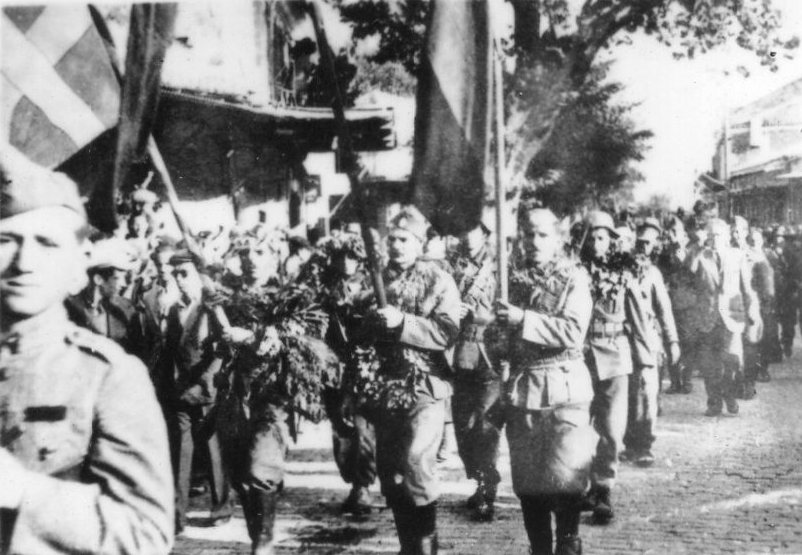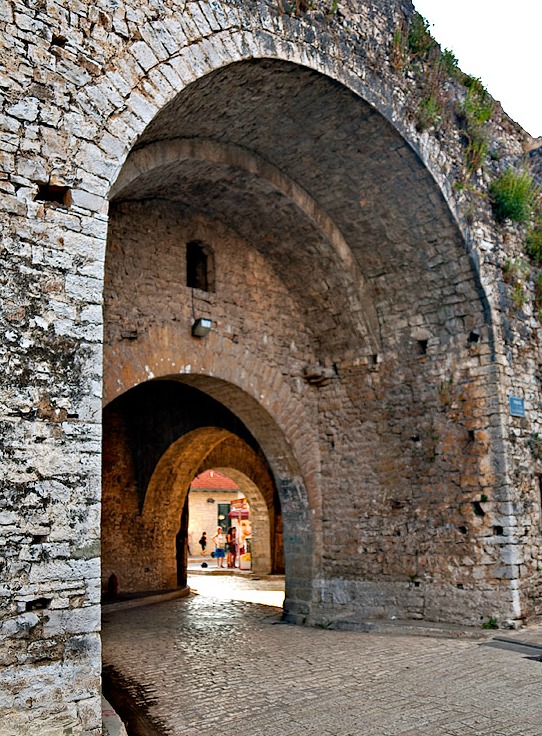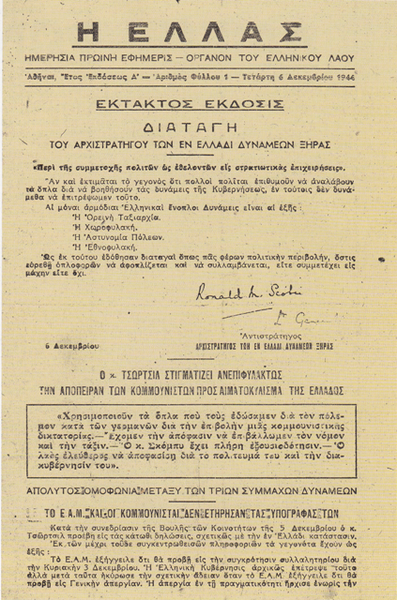|
Napoleon Zervas
Napoleon Zervas (; May 17, 1891 – December 10, 1957) was a Hellenic Army officer and resistance leader during World War II. He organized and led the National Republican Greek League (EDES), the second most significant (after National Liberation Front (Greece), EAM), in terms of size and activity, resistance organization against the Axis Occupation of Greece. Early life and army career Zervas was born in Arta, Greece, Arta, Epirus, but his ancestors came from the village of Souli. After finishing high school in 1910, he volunteered for the 2nd Mechanized Infantry Division (Greece), 2nd Infantry Division. During the Balkan Wars, he was promoted to the rank of first sergeant. Later he attended the Hellenic Army NCO School and graduated as sergeant major in 1914. Zervas was a Venizelist, and in 1916 was among the first to join the venizelist Movement of National Defence, Movement of National Defense in Thessaloniki. He served with distinction in many battles of the Macedonian front ... [...More Info...] [...Related Items...] OR: [Wikipedia] [Google] [Baidu] |
Arta, Greece
Arta () is a city in northwestern Greece and capital of the Arta (regional unit), regional unit of Arta, which is part of Epirus (region), Epirus region. The city was known in ancient times as Ambracia (). Arta is known for the Bridge of Arta, medieval bridge over the Arachthos River, as well as for its ancient sites from the era of Pyrrhus of Epirus and its well-preserved 13th-century Castle of Arta, castle. Arta's Byzantine history is reflected in its many Byzantine churches; perhaps the best known is the Panagia Paregoretissa (Mother of God the Consoling), built about 1290 by despot (court title), Despot Nikephoros I Komnenos Doukas. Etymology The origin of the city's name is quite uncertain. It is either derived from a corruption of the river Arachthos, or from the Latin word "artus" (narrow), or from the Slavic languages, Slavic word "balta" (swamp). History Antiquity The first settlement in the area of the modern city dates to the 9th century B.C. Ambracia was founded as ... [...More Info...] [...Related Items...] OR: [Wikipedia] [Google] [Baidu] |
National Liberation Front (Greece)
The National Liberation Front (, ''Ethnikó Apeleftherotikó Métopo'', EAM) was an alliance of various political parties and organizations which fought to liberate Greece from Axis Occupation. It was the main movement of the Greek Resistance during the occupation of Greece. Its main driving force was the Communist Party of Greece (KKE), but its membership throughout the occupation included several other leftist and republican groups. ΕΑΜ became the first true mass social movement in modern Greek history. Its military wing, the Greek People's Liberation Army (ELAS), quickly grew into the largest armed guerrilla force in the country, and the only one with nationwide presence. At the same time, from late 1943 onwards, the political enmity between ΕΑΜ and rival resistance groups from the centre and right evolved into a virtual civil war, while its relationship with the British and the British-backed Greek government in exile was characterized by mutual mistrust, leading ... [...More Info...] [...Related Items...] OR: [Wikipedia] [Google] [Baidu] |
National Republican Greek League
The National Republican Greek League (, ''Ethnikós Dimokratikós Ellinikós Sýndesmos'' (EDES)) was a major anti-Nazi resistance group formed during the Axis occupation of Greece during World War II. The largest of the non-communist resistance groups, its military wing, the National Groups of Greek Guerrillas (Εθνικές Ομάδες Ελλήνων Ανταρτών, ''Ethnikés Omádes Ellínon Antartón'' (ΕΟΕΑ)) concentrated its military activities in Epirus. From 1943 onwards, EDES came into confrontation with the communist-led National Liberation Front, beginning a series of civil conflicts that would lead to the Greek Civil War. Foundation and ideology The National Republican Greek League was founded on 9 September 1941 by a former army officer, Colonel Napoleon Zervas, a Venizelist who had been expelled from the army after the failed coup d'état of 1935, and two companions, Leonidas Spais and Ilias Stamatopoulos.Fleischer (1990), p. 150 Like many other re ... [...More Info...] [...Related Items...] OR: [Wikipedia] [Google] [Baidu] |
Hellenic Army
The Hellenic Army (, sometimes abbreviated as ΕΣ), formed in 1828, is the army, land force of Greece. The term Names of the Greeks, '' Hellenic'' is the endogenous synonym for ''Greek''. The Hellenic Army is the largest of the three branches of the Hellenic Armed Forces, also constituted by the Hellenic Air Force (HAF) and the Hellenic Navy (HN). The army is commanded by the chief of the Hellenic Army General Staff (HAGS), which in turn is under the command of Hellenic National Defence General Staff (HNDGS). The motto of the Hellenic Army is () , from Thucydides's ''History of the Peloponnesian War, History of the Peloponnesian War (2.43.4)'', a remembrance of the ancient warriors that defended Greek lands in old times. The Hellenic Army Emblem is the two-headed eagle with a Cross, Greek Cross escutcheon in the centre. The Hellenic Army is also the main contributor to, and lead nation of, the Balkan Battle Group, a combined-arms rapid-response force under the EU Battlegroup ... [...More Info...] [...Related Items...] OR: [Wikipedia] [Google] [Baidu] |
Minister Of Public Works ...
This list indicates government departments in various countries dedicated to public works or infrastructure. See also * Public works * Ministry or Board of Public Works, the imperial Chinese ministry overseeing public projects from the Tang dynasty to the Qing * Ministry of Works (other) {{Types of government ministers Public works Public works are a broad category of infrastructure projects, financed and procured by a government body for recreational, employment, and health and safety uses in the greater community. They include public buildings ( municipal buildings, ... [...More Info...] [...Related Items...] OR: [Wikipedia] [Google] [Baidu] |
Ministry Of Citizen Protection (Greece)
The Ministry of Citizen Protection () is the government department responsible for Greece's public security services, i.e. the Hellenic Police, the Hellenic Fire Service, Hellenic (Corrections) Prison System, the Agrarian Police and the General Secretariat for Civil Protection. The ministry existed until 2007 as the Ministry of Public Order (). On 19 September 2007, it was merged with the Ministry of the Interior, Public Administration and Decentralization and reduced to a General Secretariat within the Ministry of the Interior. On 7 October 2009, it was revived as the Ministry of Citizen Protection (Υπουργείο Προστασίας του Πολίτη) and was eventually renamed as the Ministry of Public Order and Citizen Protection on 21 June 2012. Following the electoral victory of Syriza in January 2015, it was subordinated to the Ministry of the Interior and Administrative Reconstruction and was headed by an Alternate Minister (Αναπληρωτής Υπουρ� ... [...More Info...] [...Related Items...] OR: [Wikipedia] [Google] [Baidu] |
Hellenic Parliament
The Parliament of the Hellenes (), commonly known as the Hellenic Parliament (), is the Unicameralism, unicameral legislature of Greece, located in the Old Royal Palace, overlooking Syntagma Square in Athens. The parliament is the supreme democratic institution that represents the citizens through an elected body of Members of Parliament (MPs). It is a unicameral legislature of 300 members, elected for a four-year term. From 1844–1863 and from 1927–1935, the parliament was Bicameralism, bicameral with an upper house (the Greek Senate, Senate; ) and a lower house (the Chamber of Deputies; ). Several important Greek statesmen have served as the speaker of the Hellenic Parliament. History Semi-constitutional monarchy, 1843–1862 The first national parliament of the independent Greek state was established in 1843, after the 3 September 1843 Revolution, 3 September Revolution, which forced Otto of Greece, King Otto to grant a Greek Constitution of 1844, constitution. The con ... [...More Info...] [...Related Items...] OR: [Wikipedia] [Google] [Baidu] |
Ioannina
Ioannina ( ' ), often called Yannena ( ' ) within Greece, is the capital and largest city of the Ioannina (regional unit), Ioannina regional unit and of Epirus (region), Epirus, an Modern regions of Greece, administrative region in northwestern Greece. According to the 2021 census, the city population was 64,896 while the municipality had 113,978 inhabitants. It lies at an elevation of approximately above mean sea level, above sea level, on the western shore of Lake Pamvotis (). Ioannina is located northwest of Athens, southwest of Thessaloniki and east of the port of Igoumenitsa on the Ionian Sea. The city's foundation has traditionally been ascribed to the Byzantine Emperor Justinian in the 6th century AD, but modern archaeological research has uncovered evidence of Hellenistic settlements. Ioannina flourished in the late Byzantine period (13th–15th centuries). It became part of the Despotate of Epirus following the Fourth Crusade and many wealthy Byzantine families f ... [...More Info...] [...Related Items...] OR: [Wikipedia] [Google] [Baidu] |
National Party Of Greece
The National Party of Greece () was a political party founded by the Greek General Napoleon Zervas in 1946. The party ran in the 1946 Greek legislative election and elected 25 MPs. It participated in the government of Dimitrios Maximos and Napoleon Zervas served as Minister for Public Order. In the 1950 Greek legislative election, the party received 3.65% of the vote and elected seven MPs. After the elections of 1950, the party merged into Liberal Party The Liberal Party is any of many political parties around the world. The meaning of ''liberal'' varies around the world, ranging from liberal conservatism on the right to social liberalism on the left. For example, while the political systems .... Conservative parties in Greece Defunct political parties in Greece 1946 establishments in Greece {{Greece-party-stub ... [...More Info...] [...Related Items...] OR: [Wikipedia] [Google] [Baidu] |
Liberal Party (Greece)
The Liberal Party ( , literally "Party of Liberals") was a major political party in Greece during the early-to-mid 20th century. It was founded in August 1910 by Eleftherios Venizelos, winning a landslide victory in the November 1910 legislative elections. This began an era of Liberal-dominated politics, with the party winning 9 of the 12 elections between 1910 and 1933 and Venizelos serving as Prime Minister for a total of 12 years. The party's platform was broadly modernising, liberal, social, and nationalist; a set of policies referred to as Venizelism in Greek politics. Though the party contained a social-democratic wing, it became increasingly anti-communist in the 1920s. Originally ambiguous on the issue of the Greek monarchy, the party became decidedly republican following the National Schism and went on to dominate the Second Hellenic Republic. Among its most well-known members, apart from Venizelos, were Alexandros Papanastasiou, Nikolaos Plastiras, Georgios P ... [...More Info...] [...Related Items...] OR: [Wikipedia] [Google] [Baidu] |
Dekemvriana
The ''Dekemvriana'' (, "December events") refers to a series of clashes fought during World War II in Athens from 3 December 1944 to 11 January 1945. The conflict was the culmination of months of tension between the left-wing National Liberation Front (Greece), EAM, some parts of its military arm, the Greek People's Liberation Army, ELAS, stationed in Athens, the Communist Party of Greece, KKE and the Organization for the Protection of the People's Struggle, OPLA from one side and from the other side, the , some parts of the Greek Armed Forces in the Middle East, Hellenic Royal Army, the Hellenic Gendarmerie, the Cities Police, the Organization X, among others and also the British Army. Regardless of the tensions between the left and the right, in May 1944 it had been roughly agreed in the Lebanon Conference that all non-collaborationist factions would participate in a Government of National Unity; eventually 6 out of 24 ministers were appointed by EAM. Additionally, a few week ... [...More Info...] [...Related Items...] OR: [Wikipedia] [Google] [Baidu] |




